Happy Halloween!
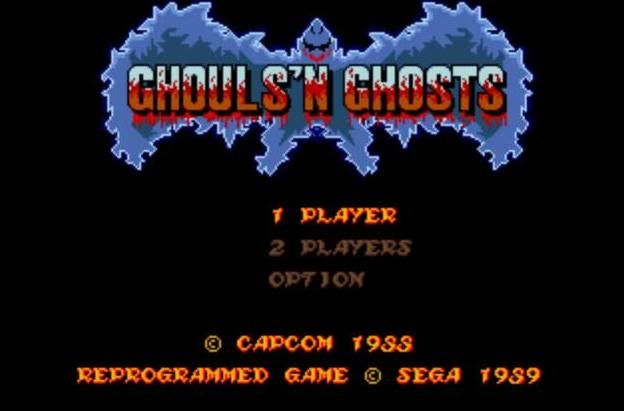
Game: Ghouls N Ghosts / Daimakaimura (大魔界村)
Developer: Sega/NEC Avenue, Licensed by Capcom
Publisher: Sega/NEC
Release Date: October 29 1988 (JPN/MD), August 14, 1989 (US/Gen), July 27, 1990 (JPN/SG)
Genre: Platformer
System: SuperGrafx/Mega Drive
The time was Christmas 1989. The Sega Genesis had been out for a few months and so has the console version of the game which tortured me in the arcades: Ghouls N Ghosts. Since reading about the impending launch of the Genesis and Ghouls n Ghosts in EGM earlier in the year, I worked as hard as an elementary school kid could just to get the system and game for Christmas. Alas, my hard work paid off and my parents kept their end of the bargain. I was blessed with a brand new Genesis. I opened the box as hastily as I could and hooked it up to the living room TV. I totally ignored the included game, Altered Beast, because Ghouls N Ghosts was the reason I wanted the Genesis. I turned on the Genesis and the gleaming Sega logo was just a preview to what was to come. I rapidly pushed the "start" button to get the damn gameplay already. There he was. Arthur standing in the middle of a graveyard with little blue grim reapers spawning from the ground. I was completely blown away by the graphics. I was in total awe. Those pictures in EGM didn't do the game justice. After years of playing Famicom (I didn't own an 'NES' as a child) and Sega Master System I've gotten used to 8-bit graphics and was totally flabbergasted by seeing arcade quality graphics in my living room.
It's now 22 years later and I still think the game looks great. I play this game with a mild smile on my face brought on by nostalgia. This is one of the most nostalgic games for me. I picked up the SuperGrafx version fairly recently. In the summer of 2009 I was driving through Iwate Prefecture in Japan on my way to Aomori when I stopped at a retro game shop along the way. I thought I'd take a quick peek to see what they had and in the PC Engine section there were several copies of Daimakaimura sitting there. I've been passively searching for the game for several years and I finally had it in my hands. Upon playing it I thought I would get the same giddy nostalgic feeling the Sega version gives me. That is not the case. The looks and feels that much different. How different? Read on.
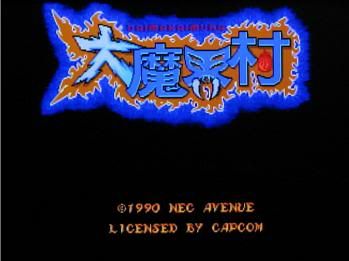
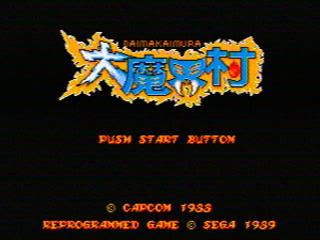
SuperGrafx (Top), Genesis/MD (Bottom)
Capcom created the series and developed the arcade version of Ghouls N Ghosts but for the console releases Sega and NEC's dev house called "NEC Avenue" developed the console versions. While the game was also released on many other home consoles such as the Sega Master System, Amiga and C64, among others, the Genesis/MD and SuperGrafx versions are by far the superior versions. Which one of these two is better than the other? Well, I will help you decide.
If you are not familiar with this game it is the sequel to the 1984 classic "Ghosts N Goblins" (Makaimura). You are a brave knight, Arthur, who must fight his was through a hell-on-earth scenario to rescue his princess. The series has been known for being extremely difficult, but like with most games after a few practice runs it becomes fairly tolerable. You begin the game wearing the requisite shining armor and equipped with unlimited lances which you hurl at enemies. If an enemy or an enemy projectile touches you, Arthur is loses his armor and is forced to run around a graveyard in his boxer shorts. If you are attacked again, Arthur dies then instantly turns into a skeleton. Tough life. If you walk or jump through specific parts of the landscape you can summon treasure chests. These treasure chests contain either a weapon,silver armor (stock), gold armor, or an evil magician. The evil magician can transform Arthur into either a helpless duck or an elderly version of himself who is still capable of attacking enemies, albeit very slowly. The gold armor allows Arthur to have a special attack. The special attack depends which weapon he is equipped with. Just hold the attack button down and allow it to charge up. Release the attack button and you release unholy hell onto the enemies in your unholy hell. One great thing about this game is the variety of weapons. Each weapon requires a certain strategy and skill as they are all very different from one another. Weapons include daggers, battle axes, fireballs, a giant sword, among others. The weapons are found in either treasure chests or vases which defeated enemies drop.
So how do the two versions stack up?
The Graphics:
While the colors do look a bit bland on the SuperGrafx there is a lot more detail, animations, and just smoother game play (no flickering or slowdown) compared to the Sega version. But it seems after you pass stage 3 NEC Aveneue just kind of gave up and the graphics start to take a nosedive. They look pretty similar to NES graphics in some parts and that isn't something a system called "SuperGrafx" should have. It's as if NEC knew the game was too difficult and nobody would make it that far to see it anyway. They were wrong. I get the feeling that perhaps the game was suddenly rushed halfway through its development. The Sega version has much better colors and textures. This is odd since the SuperGrafx has the ability for more on-screen colors than Sega's system, but the Genesis IS more powerful than a SuperGrafx.
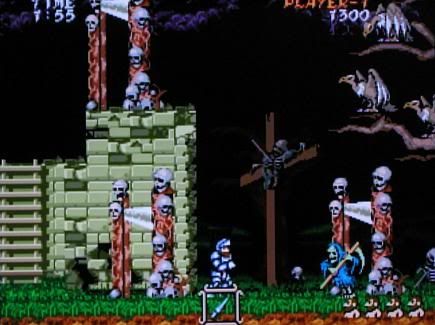

SuperGrafx (Top), Genesis/MD (Bottom)
The Sound:
While the SuperGrafx version does its best to mimic the sound effects and music of the arcade version. The Sega version on the other hand has its own unique sound effects not found in the arcade version. Due to the more superior hardware, the Sega version wins in the sound department. This is pure speculation, but I think that Sega decided to improve upon the sound of the arcade version instead of copy it. The result is more pronounced and crisp sound effects to important events happening on screen. Either way you go this game has a great and classic soundtrack. I love every level's music, especially the first. It has never gotten old. From the original 1984 game, Ghosts N Goblins, all the way to the latest iOS releases the song is a classic.
The Gameplay:
Both versions have nearly identical game play. The SuperGrafx version does have a cutscene from the arcade version at the start of the game. This doesn't affect the game at all, at least you are given a vague clue as to why Arthur is out slaying demons and vultures. One minor difference is the Sega version has the option to allow diagonal D-pad input to be recognized. For example, if you push "up" and the attack button, Arthur throws his weapon straight up into the air. If you push diagonally upwards to the left or right with the attack button, the projectile still goes straight up into the air. The SuperGrafx version is a little more strict and does not allow diagonals. If you want the dagger to go straight up, you must push "up" and "up" only. This is only a hindrance if you switch back and forth between the two versions. The Sega version has the option to turn diagonals off.
The Sega version welcomes players of all skill levels as there is a "practice" (easy) mode which makes enemies much weaker and some physical obstacles are removed from some levels. You can easily set the mode to "professional" (hard) if you want the arcade experience. The Sega version does have unlimited continues so no matter how hard you fail, you can still beat the game. The SuperGrafx version is definitely the most challenging as you are only limited to 3 continues and there is no "practice" mode. Since the SuperGrafx version costs twice as much as the Sega one at launch, players paid more money to be tortured.
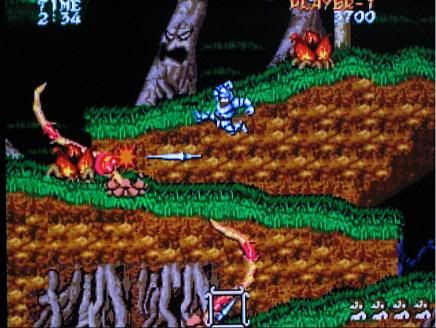
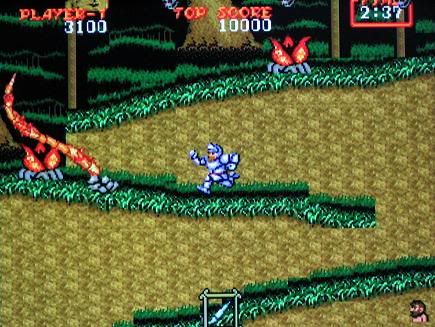
SuperGrafx (Top), Genesis/MD (Bottom)
There is one major oversight on Sega's part in their version of the game. If you are equipped with the sword it is absolutely impossible to defeat the fourth level boss (the giant maggot). The sword simply cannot reach its weak spots and you will have no choice but to reset the game. If you kill yourself you are still equipped with the sword or if you use up all your lives and continue Arthur still wields the useless sword. In the SuperGrafx and arcade versions you spawn at the mid point of the level and thus you have a chance to obtain a more useful weapon. Sega's courtesy of allowing you to spawn at the boss if you are killed by the boss is also the game's Achilles heel on the fourth stage.
One complaint I have for the game as a whole is being forced to pick up unwanted weapons. Unlike most games of the era and genre, power-ups often disappear if they are not picked up in time. This is not the case with Ghouls N Ghosts. The weapon sits there until you either pick it up or scroll past it. There are times when a weapon you'd rather not pick up is in your path and you have no choice other than to pick it up.
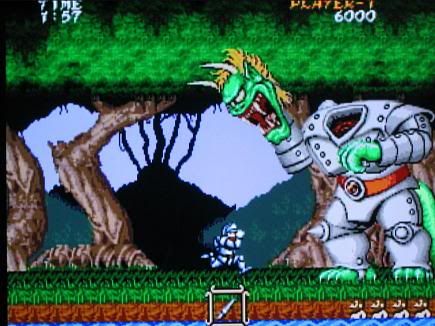
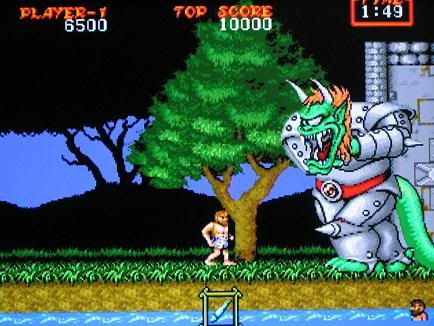
SuperGrafx (Top), Genesis/MD (Bottom)
The verdict:
I believe these two games were never meant to compete with one another. The Mega Drive was cheaper and more popular than the DOA SuperGrafx. The price of games themselves only echos this thought. At launch the 8-megabit SuperGrafx version of Daimakaimura cost $85.00 in 1990 and the 5-megabit Mega Drive version cost $45.00 in 1989. That is a big difference and so was the price difference of the consoles. The SuperGrafx cost twice as much as the Mega Drive. Neither version of the game is 'arcade perfect'. If you want to play an arcade perfect port, opt for the PS1 or PS2 version of this game. As you have just read both versions have their pros and cons.
As for me, I choose the Sega version. The Sega version is better accessible for novice players while still giving more seasoned players a great challenge.While the Sega version lacks a lot of the detail found in the SuperGrafx one, the graphics are much better on Sega's side. Also, the sound is much much better one the Genny. The advantage of the SuperGrafx version is purely subjective. It may seem more appealing to retro gamers and collectors due to its rarity, difficulty, and overall mystique. In the end no matter which version you have you are treated to a very well-designed classic platformer that holds its own against modern platformers.

World Map
Just for fun, these are the original TV commercials for both versions of the game.
Mega Drive:
http://www.youtube.com/watch?v=Hbp9bU2nqWI
SuperGrafx:
http://www.youtube.com/watch?v=iliJdVfYyVg
No backups, pirates, or emulation. My copies:

My original Christmas '89 copy is the Genesis version.


No comments:
Post a Comment